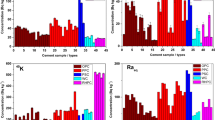Abstract
Cement is widely used as a construction material in Libya. Production plants introduce certain contaminants to the environment. The dust from such plants is carried away to neighbouring areas. This dust contains a substantial amount of contaminants depending on the origin of clays used in the production. In this study, a survey of elemental concentration of clay and cement was carried out to assess the environmental impact of such plants, especially those that are situated near residential and agricultural areas. Cement and clay samples, imported and locally produced, were analyzed. Instrumental neutron activation analysis was utilized to determine the elemental concentration of As, Ca, Ce, Co, Cr, Eu, Fe, Hf, La, Na, Rb, Sb, Sc, Sm, Ta, Th, U, Yb and Zn. Elevated concentrations of U and Th were found in a number of cement samples. The two nuclides are part of an elaborate decay scheme producing a range of radioactive elements, which emit alpha-, beta- and gamma-radiation. With 40K, they could give elevated levels of background radiation in buildings resulting in higher exposure doses. This could pose a health hazard and a detrimental effect on the well being of residents, especially in poor ventillated buildings. Also, cement is the main component for constructing underground reservoirs for collecting rainwater for drinking in private residences, so some harmful elements could leach into water. This is the first comprehensive survey of commercial cement brands and clays used in Libya. These results are intended to build a database for trace element concentrations using INAA.
Similar content being viewed by others
References
S. Al-Fakhri, Private Communication, 2004.
M. S. Khalifa, A. M. Juma, S. M. Saleh, Measurement of Radon Exhalation Rate from Various Local Building Materials, Workshop on Building Materials, Tripoli, Libya, 2001.
A. Dodonda, The Estimation of Natural Radioactivity of the Albanian Clays, Second Balkan Geophysical Congress and Exhibition, 2002, p. 188.
Trace Elements in German Standard Cement, VDZ Verein Deutscher Zementwerke e.V, D-40410, Düsseldorf, Germany, 2001.
M. S. Sultana, Y. Muramatsu, S. Yoshida, Trace and Natural Radioactive Element Contents in the Bangladeshi Soils near Industrial Area of Dhaka, Annual Report, 2001–2002.
I. Abugassa, Y. S. Khrbish, S. O. Abugassa, N. Benfaid, A. T. Bashir, S. Sarmani, J. Radioanal. Nucl. Chem., 271 (2007) 27.
M. D. Glascock, P. I. Nabelek, D. D. Weinrich, R. M. Coveney Jr., J. Radioanal. Nucl. Chem., 99 (1986) 121.
F. D. Tamás, A. Tagnit-Hamou, J. Tritthart, Trace elements in clinker and their use as “fingerprints” to facilitate their qualitative identification, in: Materials Science of Concrete — The Sidney Diamond Symposium, M. Cohen, S. Mindess, J. Skalny (Eds), Honolulu, HI, American Ceramic Society, Westerville, OH, September, 1998, p. 57.
C. Chatfield, Statistics for Technology, Chapman and Hall, 3rd ed., 1983, p. 185.
Author information
Authors and Affiliations
Rights and permissions
About this article
Cite this article
Khrbish, Y.S., Abugassa, I.O., Benfaid, N. et al. Instrumental neutron activation analysis for the elemental analysis of cement. J Radioanal Nucl Chem 271, 63–69 (2007). https://doi.org/10.1007/s10967-007-0107-3
Received:
Issue Date:
DOI: https://doi.org/10.1007/s10967-007-0107-3




